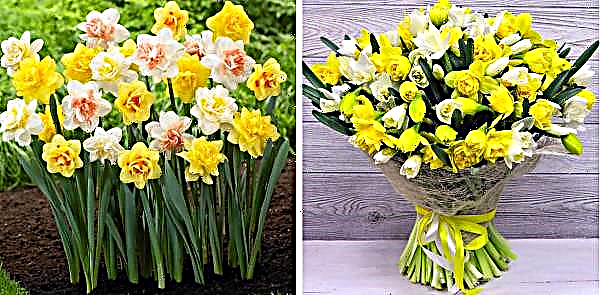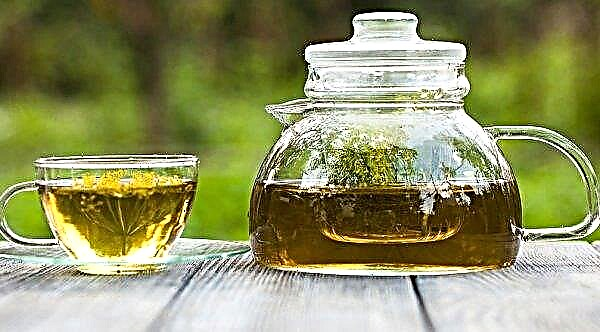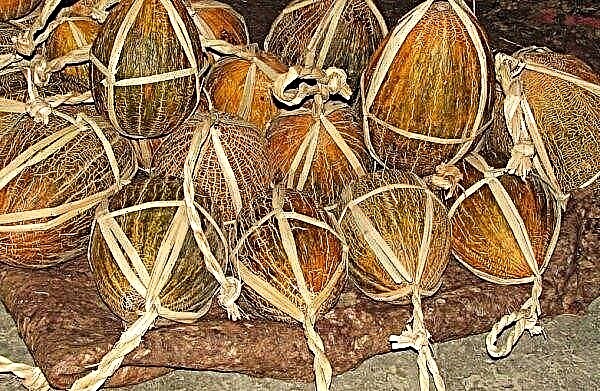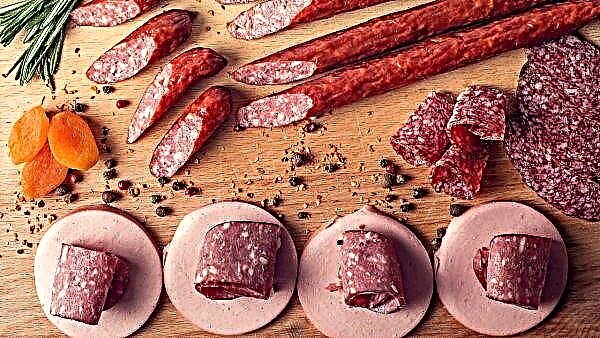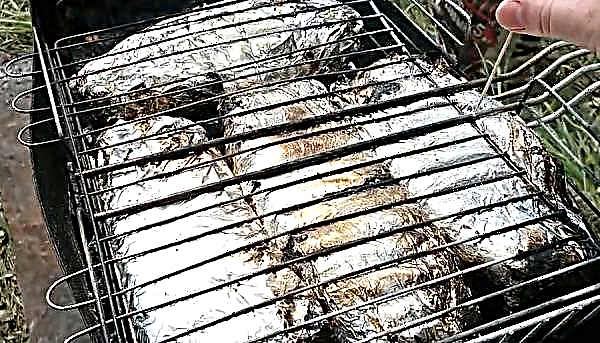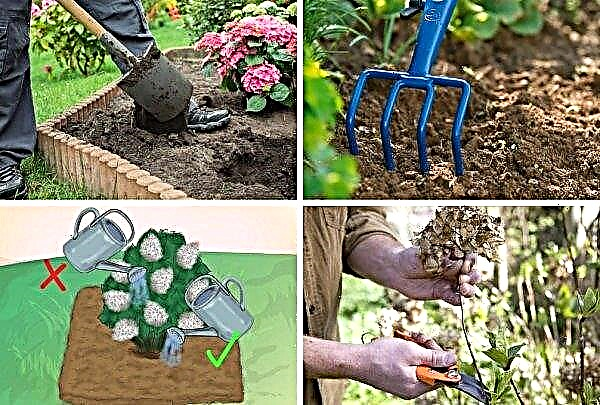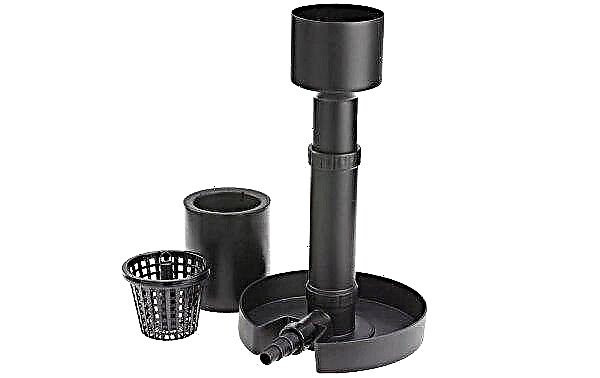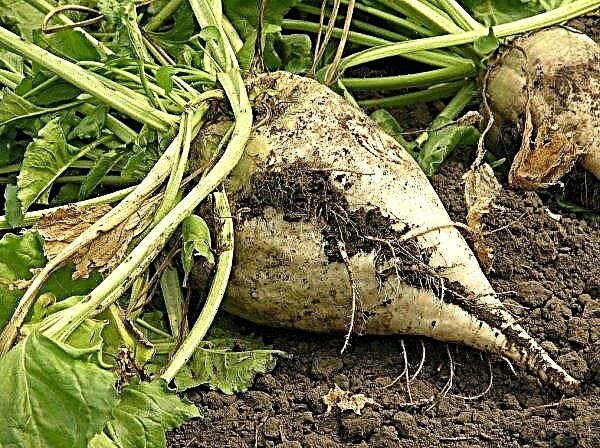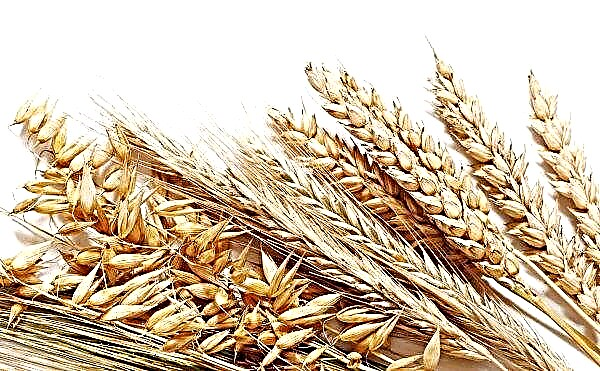Today, gardeners are presented with a huge selection of ornamental plants that can decorate the site. Among them, a special place is occupied by hydrangea - a culture with amazing external data. It has a wide variety of species and varieties. The Hydrangea Great Star, recently settled in private households, can be safely classified as the newest. You can learn about the features of the variety and the technique for growing it from this article.
Description of hydrangea Great Star
Paniculata hydrangea Great Star (Hydrangea paniculata Great Star) is a deciduous decorative shrub, the dimensions of which are quite impressive: the plant reaches 3 m in height and up to 2 m in diameter. At the same time, straight, sturdy shoots form a sprawling crown of a semicircular shape from large dark green leaves.
Did you know? According to Buddhist tradition, hydrangea tea is an important ritual drink.
The bush acquires special charm during the flowering period, which occurs in July and lasts until mid-August. At this time, many large snow-white, almost sterile flowers, similar to stars, are blooming. This, in fact, explains the name of the variety, which means “Big Star” in translation. Flowers are collected in inflorescences, each of which has a paniculate shape and can reach a diameter of 25 cm. Great Star variety was grown on the estate of the French Princess Greta Sturdtsy, fond of cultivating ornamental cultures.
Landscape design application
Hydrangea Great Star is one of the favorite plants of landscape designers. Wherever this culture is located, it invariably attracts attention. The bushes are easy to shape, look great in groups and singly. Shrub's love of moisture can be used to decorate the relief of coastal areas of artificial and natural reservoirs. It will look great as a lush hedge dividing the site on the territory.
To arrange a volumetric flowerbed, you can use several varieties with different shades of inflorescences. The snow-white of Hydrangea Great Star is emphasized by the blue-blue tones of the Blaumais variety and the red flowers of the Red Session. Today, planting in areas of coniferous crops - fir, thuja, decorative spruce and pine - has become fashionable. Hydrangea perfectly complements their union, especially since they have very similar requirements for soil composition, including acidity.

Hydrangea can also be grown in a container. The plant can be moved at any time to another part of the garden, updating the original floral arrangements. Bushes in pots adorn terraces, loggias, flat roofs of houses.
Landing
Growing hydrangea begins, of course, with its planting. This is the most important stage, during which the foundations for the successful development of culture in the future should be laid. The main task of the gardener is to choose the right site, seedling, and prepare good nutritious soil.
Seat and Seedling Selection
Many decorative flowering cultures love sunny glades. This is partly true for hydrangeas - being in the warm sunlight, the plant is less sick and blooms more luxuriantly. However, one must take into account that prolonged exposure to ultraviolet light can cause burns. In the southern regions, it is recommended to plant shrubs in partial shade, so that the plant remains in the sun for no more than 6-7 hours a day. In the northern regions, hydrangea can be planted in open areas.

Try to choose a site that will not be affected by strong gusts of wind and drafts, as they not only drain the culture, but can also disturb the shape of the bush. You also need to consider - hydrangea loves moist soil, but in conditions of constant dampness it often gets sick. If you plan to plant a plant near a pond, or in a waterlogged area, take care of laying a drainage layer at the bottom of the planting pits. It can be made of any kind of small stone, as well as of broken brick, the remains of which are often found in summer cottages after construction.
Important! Hydrangea consumes a lot of moisture, so it is not recommended to plant it near tall trees, whose powerful roots will absorb most of the water from the soil.
Seedlings are best purchased at nurseries or garden centers. You need to carefully inspect the material - if you find damaged, dried or painful areas, choose another healthy seedling. For planting, plants aged 2-3 years are best suited. Seedlings can be grown independently in different ways, but in the process of transplanting, you also need to pay attention to their type. Immediately before planting, it is recommended to treat the roots of young plants in a weak solution of potassium permanganate.

Landing time
Hydrangea is planted in spring and autumn. The choice of this or that time of the year depends on the climatic features of the region. There are no restrictions on the choice of season for the southern regions - hydrangea takes root well in the spring, and autumn planting in September allows the plant to adapt in a new place before the onset of real cold weather. As for the northern regions - here it is advisable to plant hydrangea exclusively in late March or early April. This is because winter comes here much earlier, and shrubs planted even in early autumn can suffer from frost.
Soil preparation
Hydrangea Great Star has special soil requirements. Firstly, it should be acidified soil with a level of approximately 5.5 pH. If lime prevails in the composition, this can provoke the appearance of chlorosis - a serious disease that requires treatment.
 Check the acidity level using the indicator and bring it to the desired level using a solution of citric acid (50 g per 10 liters of water). Preserve acidity will help mulch from coniferous needles.
Check the acidity level using the indicator and bring it to the desired level using a solution of citric acid (50 g per 10 liters of water). Preserve acidity will help mulch from coniferous needles.
In addition to acidity, the composition of the soil itself is important. Hydrangea prefers nutritious soil; best if it will consist of land, peat and sand, taken in a ratio of 2: 1: 1. For each landing, you can add a bucket of humus or compost, which will serve as a good fertilizer. Such a mixture can be prepared in advance, and already during planting, fill pits with seedlings with it.
When everything is ready, you can proceed directly to the landing, which consists of the following steps:
- Form a landing hole. Its average size is 50 cm in depth and in width, but if you purchased a seedling with a closed root system, the pit can be increased by adjusting to the size of an earthen coma. When group planting, observe a distance between the bushes of at least 1 m.
- Place drainage at the bottom of the pit, then a small layer of the prepared soil mixture. Fertilize - for example, 20 g of Nitrofoski.
- Set the seedling.
- Fill the pit with nutrient soil to the top, lightly tamp.
- Abundantly water the planting, delivering about 15 liters of settled water to 1 bush. If necessary, citric acid can be added to the water.
- Mulch the soil with horse peat, sawdust or needles.

Great Star Care
Great Star can not be called particularly demanding in terms of care, but the plant also has its own preferences. In order for hydrangea to truly please with its decorative effect, the rules of agricultural technology must be observed. Otherwise, the plant will grow poorly and may not bloom at all (this happens, for example, with incorrect pruning).
Watering
The culture is very demanding on watering - it literally “drinks” moisture from the soil in large quantities. It is necessary to water hydrangea 2 times a week, delivering to each bush up to 20 liters of water. It is recommended to pre-protect the water in the sun. Watering must be done carefully, trying to prevent water from falling on leaves and flowers. In a dry season, you can increase the number of procedures up to 3 times. Several times during the season, it is necessary to loosen the soil, remove weeds. After watering, the soil is mulched, discarding the old layer.

Top dressing
Grade Great Star is responsive to top dressing. They are introduced several times during the season: in early spring, during the formation of buds, during flowering and in autumn, preparing hydrangea for winter. Immediately after the snow melts, it is recommended to apply fertilizers that contain nitrogen to ensure the abundant appearance of green strong shoots. You can use urea: 25 g of the product in a bucket of settled water should be diluted per 1 bush. At the same time, you can conduct "Nitroammofosku", adding fertilizer under the bush. After spring rains, top dressing will be gradually absorbed into the soil, saturating it with all the necessary substances.
Important! Organic dressing in the fall can not be made.
During the formation of buds, nitrogen fertilizers are not needed, since now the main task is not the growth of shoots, but the abundant development of inflorescences. At this time, the plant needs more phosphorus, potassium and other useful trace elements. You can use a liquid complex fertilizer, for example, “Ferimiks”. Fertilizing is repeated at the beginning of flowering. After flowering, the process of forming peduncles of the next year begins, so the plant must be fed. Fertilizers are applied in September: for one bush, take 1 tbsp per bucket of water. l sulfuric acid and superphosphate.

Pruning
The main pruning of panicled Hydrangea Great Star is carried out in early spring, in March. Since its flower buds are formed on the shoots of the current year, you need to cut off all last year's shoots so that one pair of buds remains. Of these, new branches will form in the next season, on the tops of which inflorescences will grow. If you neglect such a haircut, the bushes will quickly thicken, and the inflorescences will become small.
Further, throughout the season, you need to monitor the shrubbery. Periodically cut off all damaged, dried branches, as well as those that have signs of disease. This is the so-called sanitary pruning.

Wintering
Hydrangea tolerates winter frosts quite well, withstanding a drop in temperature to -25 ° C. In the southern regions, it is enough to add a thick layer of mulch (15–20 cm) under the bushes. In temperate and northern latitudes, it is recommended to insulate the plant. To do this, build protection from several layers. First, the bushes need to be cleaned of unfit shoots and lower leaves. Then hydrangea is treated with drugs from diseases and pests, the soil is loosened, fertilizers are applied, and mulch is covered.
Did you know? Hydrangea is considered a sacred plant for Buddhists. On Buddha's birthday, flowers decorate temples.
When the preparatory procedures are carried out, you can proceed to the design of the shelter. This is usually done in September. A wooden board or roofing material is laid under the bush. The shoots need to be gathered together and tilted as low as possible to the ground, bent to the litter and fixed. A layer of protective material is laid on top, as such an ordinary burlap is suitable. A layer of sawdust is poured on top of it, and polyethylene on top. It is better to make holes in the glued base to ensure air penetration in the autumn period. With the onset of frost, polyethylene is covered with spruce branches.

Breeding
For propagation of hydrangea, different methods are used, at the discretion of the gardeners themselves. The most common is cutting cuttings, from which new seedlings are then grown for planting. Hydrangea can also be propagated by layering or seeds.
Seeds
Planting a seed is the most time-consuming way. They begin sowing in February, but before planting they need to germinate the material - they spread it on moist cotton and wait. When the seeds begin to swell, you need to prepare the container - it is filled with a mixture of sheet soil, sand and peat, taken in identical parts.
Seeds are simply laid on the surface of the soil without deepening. From above they need to be sprinkled with a thin layer of sand and watered. The container is covered with film or glass. Every day you need to remove the shelter so that the greenhouse is ventilated, and moisten the soil (it is better to use a spray gun). In a few weeks, the first sprouts will appear - they can already be planted in separate containers.
 To grow ready-made seedlings, you need to install pots with sprouts in a warm place, regularly spray and feed with fertilizers ("Agricola", "Agrovita"). Plants should not be placed in direct sunlight, which can cause burns; bright diffused light is preferred. After 2 years, the seedlings can be transplanted into the open ground.
To grow ready-made seedlings, you need to install pots with sprouts in a warm place, regularly spray and feed with fertilizers ("Agricola", "Agrovita"). Plants should not be placed in direct sunlight, which can cause burns; bright diffused light is preferred. After 2 years, the seedlings can be transplanted into the open ground.
Cuttings
Unlike the previous one, this method is simpler and faster. Cuttings need to be cut from green shoots, since lignified roots are very poorly rooted. The material can be collected in the spring, but it is better to do this in the middle of summer, when buds begin to tie on the bush.
Cuttings with 2-3 pairs of leaves are cut from the tops of young shoots. The lower cut is done at an angle of 45 °, and the upper one is straight. If they have buds formed on them, they must also be cut. It is advisable to place the resulting material in the solution of the growth stimulator "Epin Extra" to ensure successful rooting. After that, the lower cut is dusted with Kornevin.
For planting, you need to prepare a container with soil consisting of sand and peat in a ratio of 1: 2. Cuttings are planted to a depth of 2-3 cm, watered. Plants should be located at least 5 cm apart. At the final stage, the cuttings are sprayed with settled water, after which the container is covered with a film, a glass or plastic cover, and installed in a warm, dark place.
Once a week you need to open the greenhouse and water the cuttings. In hot weather, procedures can be performed more often. A month later, new leaflets will appear - this means that the rooting was successful. The cover is removed, and the cuttings are planted in separate boxes for growing. It will be possible to transplant them into the open ground next spring.
Layering
In spring or autumn, you can do hydrangea cultivation by layering. Choose strong healthy side shoots from different sides of the bush. Dig grooves in the soil, about 15 cm deep. Lay each of the shoots in your groove and sprinkle with soil. It is important that the tips of the branches are located vertically above the soil. After that, water the beds well. Moisten them regularly so that the soil does not dry out.
After 5-7 weeks, rooting will occur, and you will see the emergence of new shoots. They can be carefully separated from the mother bush and transplanted into separate sections.Did you know? In North America, hydrangea grew 70 million years ago. — This fact was established during archaeological research.

Hydrangea diseases and pests
Growing in favorable conditions and receiving proper care, hydrangea is extremely rare, so it is very important to choose the right place for planting and monitor the condition of the soil.
Most often, diseases such as:
- powdery mildew - fungus, progressing to a greater extent on young shrubs, but the possibility of damage to adult plants is not excluded. It is not difficult to determine the disease: a gray-violet coating is formed on the back of the leaf plates, and pale yellow spots are formed on the front. To cure the culture, you need to remove all damaged fragments and burn, and then spray with “Fitosporin”;
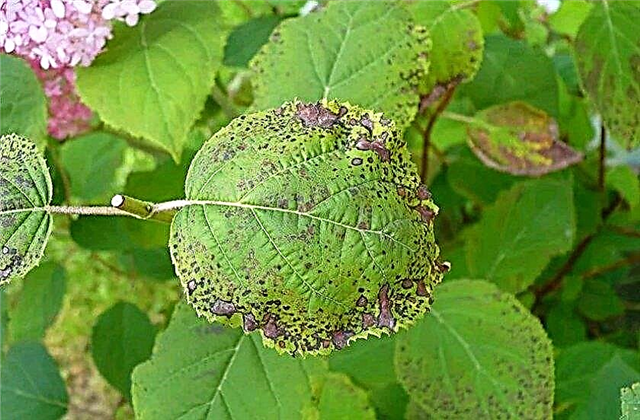
- white rot - a fungal infection that most often propagates in biological debris - in weed grass or trimmed shoots that are not collected on time from the site. Through the roots, the fungus penetrates into the bush, after which the darkening of the stems is visible, often the shoots rot at the very base, and a light white coating forms on the leaves;

- Septoria - the infection first affects the lower fragments of the shoots, and then moves higher. Leaf plates are covered with small bright spots with a brown fringing. All diseased areas are cut out, and the bush is treated with "Rodomit";

- chlorosis - An ailment that occurs due to a lack of iron in the soil. The leaves of the bush begin to turn yellow and dry very quickly. At the same time, the veins of leaf blades often remain green. The treatment comes down to feeding the soil with iron sulfate and aluminum sulfate. Tools are diluted in water according to the instructions and water the barrel circle.
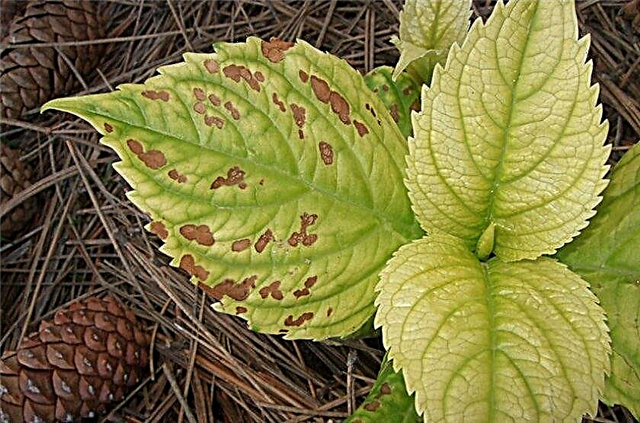
In addition to diseases, pests can threaten the development of the bush, namely:
Hydrangea Great Star is a magnificent ornamental plant, a real decoration of landscape design. Subject to the rules of cultivation, it will delight the owners all season, replacing the riot of green shades with the colorfulness of variegated inflorescences. Yes, and faded buds do not lose their attractiveness, emphasizing landscape preparation for the coming autumn.





